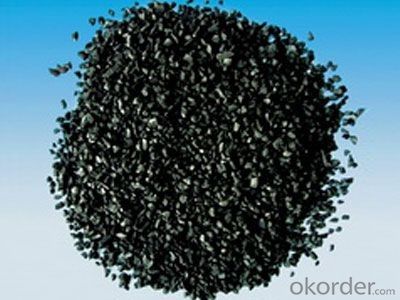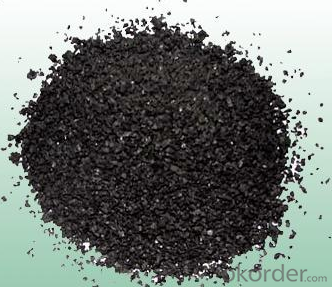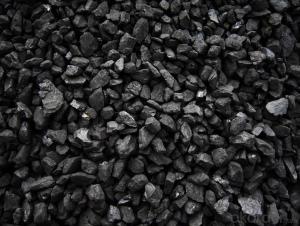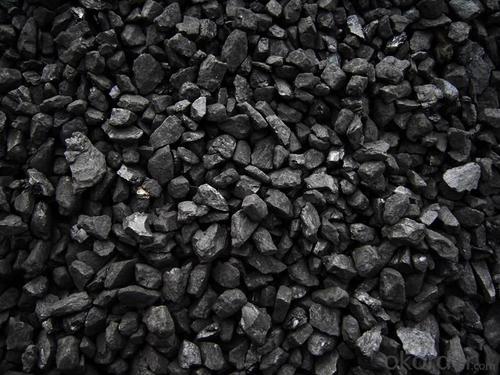High Quality Best Clean Coal Low Price : 6500-6600
- Loading Port:
- Tianjin
- Payment Terms:
- TT OR LC
- Min Order Qty:
- 1000 m.t.
- Supply Capability:
- 20000 m.t./month
OKorder Service Pledge
OKorder Financial Service
You Might Also Like
1.Structure of Anthracite Description
Anthracite is made from Shanxi,the coal capital of the word .The quality is very high due to its unique resource .It has been exported to most of the world ,especially to Japan and Korea,as well as mid east.
It is commonly used in drinking water ,food industry ,chemical /dyeing industry ,sea/salt water filtration ,petro-chemical industry ,pulp/paper industry ,sauna,spa,pool,boiler ,etc.
Advantages:
1. Longer Filter Runs2. Faster Filtration3. Long Lifetime4. Good Separation Characteristics5. Savings water and power in washing6.Removes more iron and manganese salts tration ,petrochemical industry ,pulp /paper industry ,sauna,spa,pool,boiler,etc.
2. Main Features of Anthracite
Fixed Carbon: 78 %
Ash: 18 %
Volatile Matter: 4 %
Sulphur: 1.0 %
Moisture: 11 %
Gross Calorific Value: 6450 Kcal
Size: 0 mm - 19 mm: 90%
3. The Images of Anthracite


4. The Specification of Anthracite
1. Fixed carbon: 90%min
2.Uniform particles
3.Good separation characteristics
4. Long life
5. Widely used
6.activated anthracite:
7.Certificate: ISO9001, ISO9002, NSF
8.Usage: for water and air purification, etc.
5.FAQ of Anthracite
1). Q: Are you a factory or trading company?
A: We are a factory.
2). Q: Where is your factory located? How can I visit there?
A: Our factory is located in ShanXi, HeNan, China. You are warmly welcomed to visit us!
3). Q: How can I get some samples?
A: Please connect me for samples
4). Q: Can the price be cheaper?
A: Of course, you will be offered a good discount for big amount.
- Q: Is carbon a conductor?
- Carbon is an element, not an organization, and when the carbon atoms are arranged in different spatial forms, the physical and chemical properties of the substances formed are different. When the formation of lamellar material carbon atom with six ring as a unit, the material is a conductor, which is familiar to us when graphite, carbon atoms to form a tetrahedral structure, which is macroscopically when diamond is an insulator. There are many forms of carbon elements, which are not listed in one by one
- Q: How does carbon impact the prevalence of tsunamis?
- Carbon does not directly impact the prevalence of tsunamis. Tsunamis are primarily caused by seismic activity, such as earthquakes or volcanic eruptions, which are unrelated to carbon emissions. However, rising carbon levels can contribute to global climate change, leading to the melting of polar ice caps and potentially increasing the risk of coastal flooding, which can indirectly amplify the impact of a tsunami.
- Q: What are the different types of carbon-based polymers?
- There are several different types of carbon-based polymers, each with its own unique properties and applications. Some of the most common types include: 1. Polyethylene (PE): This is one of the most widely used polymers and is known for its high strength and chemical resistance. It is commonly used in packaging materials, plastic bottles, and pipes. 2. Polypropylene (PP): PP is similar to PE but with a higher melting point and better resistance to heat. It is commonly used in automotive parts, textiles, and food packaging. 3. Polystyrene (PS): PS is a lightweight and rigid polymer that is commonly used in packaging materials, disposable utensils, and insulation. 4. Polyvinyl chloride (PVC): PVC is a versatile polymer that can be rigid or flexible depending on the additives used. It is commonly used in pipes, electrical insulation, and flooring. 5. Polyethylene terephthalate (PET): PET is a strong and lightweight polymer that is commonly used in beverage bottles, food containers, and synthetic fibers. 6. Polyurethane (PU): PU is a flexible and durable polymer that is commonly used in foams, coatings, adhesives, and textiles. 7. Polycarbonate (PC): PC is a strong and transparent polymer that is commonly used in eyeglass lenses, safety goggles, and electronic components. 8. Phenolic resins: These polymers are known for their excellent heat resistance and are commonly used in coatings, adhesives, and electrical components. These are just a few examples of the many carbon-based polymers that exist. Each type has its own specific properties and applications, making them suitable for a wide range of industries and products.
- Q: How does carbon impact the prevalence of droughts?
- Droughts are significantly influenced by carbon, specifically in the form of carbon dioxide (CO2) emissions. The prevalence of droughts is attributed to the increased levels of carbon in the atmosphere, which contribute to global warming and impact climate patterns globally. Human activities, such as the burning of fossil fuels and deforestation, release carbon dioxide into the atmosphere. This carbon dioxide acts as a greenhouse gas, trapping heat from the sun and causing the Earth's temperature to rise. As the global temperature increases, precipitation patterns and evaporation rates undergo changes. Warmer temperatures accelerate evaporation, leading to more water evaporating from lakes, rivers, and soil. This increased evaporation, combined with altered precipitation patterns, results in drier conditions and reduced water availability in certain regions. Furthermore, the rising temperatures contribute to the intensification of the water cycle, leading to more extreme weather events. These events include more frequent and severe droughts, as well as intense rainfall in some areas, increasing the risk of floods. Moreover, carbon emissions also impact atmospheric circulation patterns, such as the weakening of the jet stream. The jet stream plays a crucial role in directing weather systems across the globe, including rain-bearing weather fronts. When it weakens, weather systems become stagnant, resulting in prolonged drought periods in certain regions. In summary, human activities that increase carbon levels in the atmosphere have a direct influence on global warming and climate change. These changes in climate patterns and atmospheric circulation, along with the intensification of the water cycle, significantly affect the occurrence and severity of droughts worldwide. Therefore, it is essential to reduce carbon emissions and address climate change in order to minimize the impacts of droughts on ecosystems, agriculture, and human populations.
- Q: What are the properties of carbon-based ceramics?
- Carbon-based ceramics, also known as carbon ceramics, are a unique class of materials with a combination of properties that make them highly desirable for various applications. These properties include: 1. High temperature resistance: Carbon-based ceramics exhibit exceptional thermal stability, allowing them to withstand extremely high temperatures without undergoing significant degradation or structural changes. This property makes them ideal for use in high-temperature environments such as aerospace components, brake systems, and heat shields. 2. Low density: Carbon ceramics are characterized by their low density, which contributes to their lightweight nature. This property is advantageous in applications where weight reduction is critical, such as in the automotive and aerospace industries, as it can enhance fuel efficiency and improve overall performance. 3. High hardness and wear resistance: Carbon-based ceramics possess exceptional hardness and wear resistance, making them highly durable and capable of withstanding abrasive forces. This property makes them suitable for use in cutting tools, bearings, and other applications where resistance to wear and erosion is required. 4. Excellent chemical resistance: Carbon ceramics are known for their excellent chemical resistance, which allows them to resist corrosion and degradation when exposed to various aggressive chemical environments. This property makes them valuable in chemical processing, semiconductor manufacturing, and other industries where resistance to chemical attack is crucial. 5. Good electrical conductivity: Unlike traditional ceramics, carbon-based ceramics exhibit good electrical conductivity due to the presence of carbon in their composition. This property makes them useful in applications that require both thermal insulation and electrical conductivity, such as heating elements, electrodes, and electronic components. 6. Tailorable properties: Carbon ceramics offer the advantage of being able to tailor their properties to specific requirements by varying the composition and processing methods. By adjusting factors such as carbon content, porosity, and microstructure, the mechanical, thermal, and electrical properties of carbon ceramics can be customized to meet specific application needs. In summary, carbon-based ceramics possess a unique combination of properties, including high temperature resistance, low density, high hardness, excellent chemical resistance, good electrical conductivity, and the ability to tailor their properties. These properties make them valuable materials in a wide range of industries, including aerospace, automotive, chemical processing, and electronics.
- Q: What kind of industry does high-performance carbon fiber belong to?
- High performance carbon fiber is used in many industries, such as automobiles, bicycles, and even the aviation industry.. If you look at the industry type, many industries have high-performance carbon fiber figure, if divided by the industry attributes, should belong to the emerging industry, the future potential of the industry
- Q: What are the effects of carbon emissions on the stability of the atmosphere?
- The stability of the atmosphere is significantly affected by carbon emissions, resulting in various consequences. One primary effect is the intensification of the greenhouse effect, which leads to global warming and climate change. Human activities emit carbon dioxide (CO2), the main greenhouse gas, which traps heat in the atmosphere and prevents it from escaping into space. Consequently, the Earth's average temperature rises, causing a range of negative impacts. One consequence of carbon emissions is the alteration of weather patterns. Increased atmospheric temperatures can result in more frequent and severe heatwaves, droughts, and wildfires. Conversely, it can also lead to heavier rainfall and more frequent and intense storms, such as hurricanes and cyclones. These changes disrupt ecosystems, agriculture, and water availability, posing risks to human health, food security, and infrastructure. Another result of carbon emissions is the melting of polar ice caps and glaciers. As the atmosphere warms, ice sheets in Antarctica and Greenland melt, contributing to rising sea levels. This poses a significant threat to coastal regions, increasing the risk of flooding, erosion, and the loss of valuable ecosystems. The displacement of coastal communities and the loss of land also create social and economic challenges. Additionally, carbon emissions contribute to ocean acidification. When seawater absorbs CO2, it reacts with water molecules and forms carbonic acid, lowering the ocean's pH and making it more acidic. This acidity harms marine life, particularly coral reefs and organisms dependent on calcium carbonate for their shells and skeletons. The degradation of coral reefs not only affects marine biodiversity but also impacts the livelihoods of communities dependent on fisheries and tourism. Furthermore, carbon emissions trigger feedback loops that further impact the stability of the atmosphere. For example, as the Earth warms, permafrost in the Arctic regions begins to thaw, releasing significant amounts of methane, another potent greenhouse gas. This release of additional greenhouse gases amplifies global warming, creating a harmful cycle. In conclusion, carbon emissions have far-reaching effects on the stability of the atmosphere. They contribute to global warming, alter weather patterns, cause the melting of ice caps, acidify the oceans, and trigger feedback loops. It is crucial to address carbon emissions through sustainable practices, renewable energy sources, and international cooperation to mitigate these effects and ensure a stable and livable atmosphere for future generations.
- Q: What are the impacts of carbon emissions on the stability of kelp forests?
- Carbon emissions have significant impacts on the stability of kelp forests. Increased carbon dioxide levels in the atmosphere lead to ocean acidification, which negatively affects the growth and survival of kelp. Acidic conditions hinder the ability of kelp to absorb essential nutrients, weaken their structure, and make them more susceptible to damage from storms and other disturbances. Additionally, rising ocean temperatures associated with carbon emissions can lead to the expansion of harmful algal blooms that compete with kelp for light and nutrients. These combined effects pose a threat to the stability and biodiversity of kelp forests, with potential cascading impacts on the marine ecosystem.
- Q: Whether the CO2 content in the boiler smoke can not be measured, the measurement of carbon content of fly ash ah? @ @ Thank you very much!!!
- No The amount of unburned carbon in the fly ash is not carbon dioxide.CO2 measurements are simple.
- Q: What are the effects of carbon emissions on animal populations?
- Animal populations are profoundly affected by carbon emissions, which result in the disruption of ecosystems and the loss of habitats. The rise in carbon dioxide levels in the atmosphere leads to an increase in the Earth's temperature, causing climate change. This change in climate alters the availability of resources like food and water, making survival and reproduction more challenging for animals. Moreover, carbon emissions contribute to the acidification of the ocean. Seawater absorbs carbon dioxide, creating carbonic acid and lowering the ocean's pH. This acidification negatively impacts marine life, especially species that rely on calcium carbonate to build shells or skeletons, such as corals and shellfish. As their habitats become more corrosive, these animals struggle to survive and reproduce, resulting in significant population declines. Additionally, carbon emissions are closely associated with air pollution, which directly and indirectly affects animal populations. High levels of air pollution, particularly nitrogen dioxide and particulate matter, can cause respiratory problems and other health issues in animals. This reduces their fitness and increases mortality rates, ultimately influencing the overall population size. Lastly, carbon emissions contribute to deforestation and the destruction of habitats. Human activities like agriculture and urbanization clear more land, displacing animal populations and forcing them to adapt to fragmented landscapes. This fragmentation limits their movement, access to resources, and increases their vulnerability to predation and other threats. In conclusion, carbon emissions have extensive effects on animal populations, including habitat loss, climate change, ocean acidification, air pollution, and deforestation. These impacts disrupt ecosystems and jeopardize the survival of numerous animal species. It is crucial to address carbon emissions and reduce our carbon footprint to mitigate these detrimental effects and safeguard the Earth's biodiversity.
Send your message to us
High Quality Best Clean Coal Low Price : 6500-6600
- Loading Port:
- Tianjin
- Payment Terms:
- TT OR LC
- Min Order Qty:
- 1000 m.t.
- Supply Capability:
- 20000 m.t./month
OKorder Service Pledge
OKorder Financial Service
Similar products
Hot products
Hot Searches




















